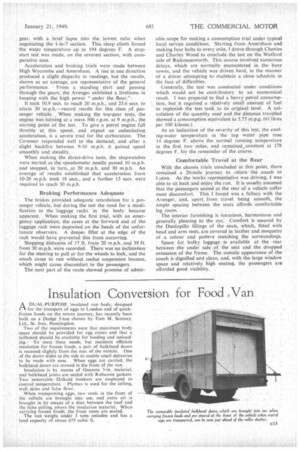Insulation Conversion for Food Van
Page 19

If you've noticed an error in this article please click here to report it so we can fix it.
.A DUAL-PURPOSE insulated van body, designed rA_ for the transport of eggs to London and of quickfrozen foods on the return journey, has recently been built on a Dodge 5-ton chassis by Torn M. Scot ney,
Ltd., St. Ives, Huntingdon. . • ,
Two of the requirements were that maximum body 'space should be provided for egg .crates and that a tailboard should be available for loading and unloading.-To 'meet 'these needs, but maintain efficient insulation for frozen foods, a pair of bulkhead doors is recessed slightly from the rear of the vehicle. One of the doors slides to the side to enable small deliveries to •be made with ease. When eggs are carried, the bulkhead doors are stowed in the front of the van.
' Insulation is by means of Onazote 3-in, material. and btilkhead joints are sealed with Rithazote gaskets. Two remcivable' Drikold bunkers are employed to Control temperature..'.Plymax is used for the ceiling, wail. skins and false floor.
• When transporting eggs, two vents in the front of the • vehicle are .brought into use, and extra air is brought in.by means of a duet between the roof and the false ceiling, above the insulation material. When carrying frozen foods. the front vents are sealed.
The van weighs. under 3 tons unladen and has a load capacity of about 675 cubie ft,




























